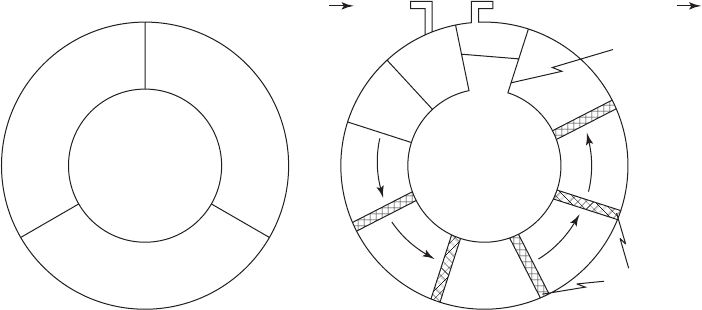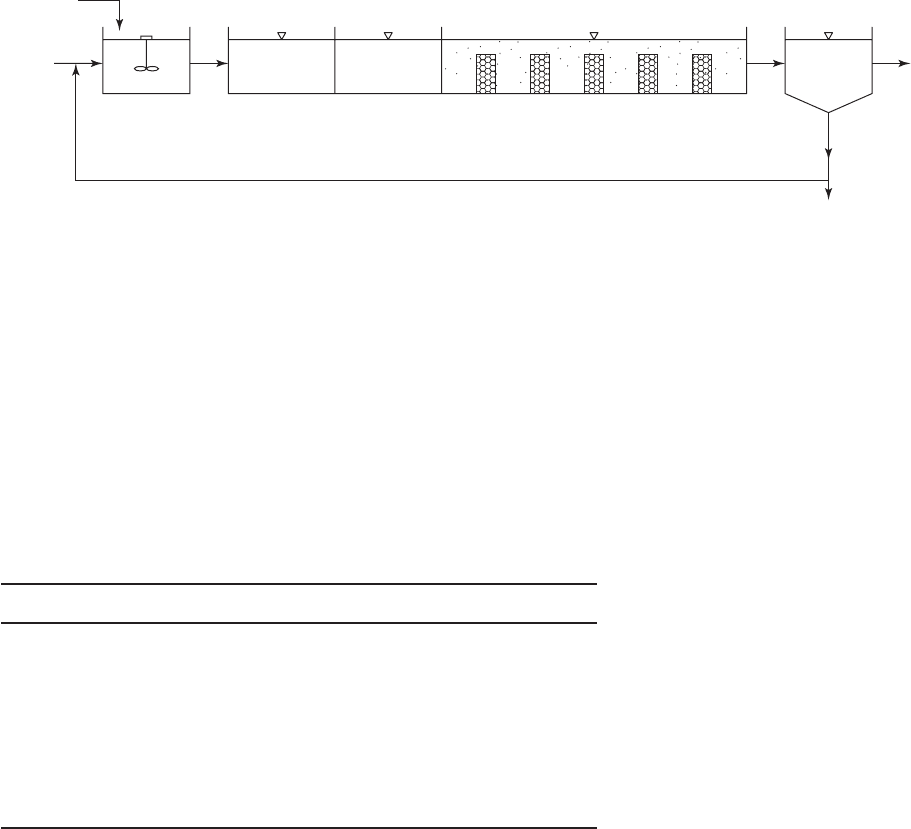Water and Wastewater Engineering
Подождите немного. Документ загружается.


28-14 WATER AND WASTEWATER ENGINEERING
TABLE 28-10
Advantages and disadvantages of MBR reactors
Parameter Comment
Advantages
Effluent quality Consistently high-quality with effluent solids concentrations less than 1 mg/L
Footprint Footprint is smaller because primary and secondary clarifiers can be eliminated. Aeration
basin can be smaller because MLSS concentration is higher.
Sludge prod
uction Long SRTs result in lower sludge production compared to conventional activated sludge
Ease of expansion Because the membrane systems are modular, they can easily be expanded
Robust operation System can operate within a wide range of SRTs
Reduced disinfection require
ments Because the membrane serves as a physical mechanism to remove microorganisms and
turbidity, the chlorine demand is less and the higher transmissivity means less energy is
needed for UV disinfection
Disadvantages
Limited flow capacit
y Because of the hydraulic limits of the membrane, the range of flows that can be treated is
less than conventional activated sludge. The peaking factor is 2.0 to 2.5.
Increased potential for foam Operating conditions in a MBR system often favor foaming
System monitoring and maintenance MBRs must be closely monitored to d
etect changes in flux rate and permeability.
Cost Although the capital cost of membranes is falling rapidly, the capital cost is still
significantly higher than that of conventional activated sludge
Limited availability of long-term data Because of the limited availability of long-term data, it is difficult to verify
man
ufacturer’s claims
A dapted from WEF, 2006c.
TABLE 28-9 (continued)
Process Advantages Limitations
SBR Both nitrogen and phosphorus removal are
possible
Process is easy to operate
Mixed-liquor solids cannot be washed out by
hydraulic surges
Quiescent settling may produce lower effluent
TSS concentration
Flexible operation
More complex operation for N and
P removal
Needs larger volume than SBR for N removal
only
Effluent quality depends upon reliable decanting
facility
Design is more complex
Skilled maintenance is required
More suitable for smaller flow roles
PhoStrip
™
Can be incorporated easily into existing
activated sludge plants
Process is flexible; phosphorus-removal
performance is not controlled by BOD/
phosphorus ratio
Significantly less chemical usage than
mainstream chemical precipitation process
Can achieve reliable effluent orthophosphate
concentrations
less than 1 mg/L
Requires lime addition for phosphorus
precipitation
Requires higher mixed-liquor dissolved oxygen
to prevent phosphorus release in final clarifier
Additional tank capacity required for stripping
Lime scaling may be a maintenance problem
Source: Metcalf & Eddy, 2003.

CLEAN WATER PLANT PROCESS SELECTION AND INTEGRATION 28-15
TABLE 28-11
Typical average day effluent concentrations from granular media filtration of secondary effluent
Filter influent type
Without chemical coagulation—
single or multimedia filter,
effluent SS, mg/L
With tertiary chemical coagulation—dual
or multimedia filter
Effluent SS,
mg/L Total P, mg/L
Turbidity,
NTU
High-rate trickling filter effluent 10–20 0–3 0.1 0.1–0.4
Two-stage trickling filter effluent 6–15 0–3 0.1 0.1–0.4
Contact stabilization effluent 6–15 0–3
0.1 0.1–0.4
Conventional activated sludge effluent 3–10 0–5 0.1 0.1–0.4
Extended aeration effluent 1–5 0–5 0.1 0.1–0.4
Aerated/facultative lagoon effluent 10–50
0–30
a
0.1
N/A
a
a
Poor removal efficiency can result from filtering lagoon effluent because of the presence of algae.
Source: WEF, 1998.
Other Considerations
Infiltration and Inflow Reduction. The implementation of comprehensive programs to reduce
infiltration and inflow have a direct impact on process performance and an indirect impact on
process selection. Plant influent flow rates may be reduced between 5 and 25 percent. In general,
this would be expected to have a positive effect on clarifier performanc
e. However, the wastewa-
ter strength is also likely to increase significantly.
Water Conservation. The increasing c ost of water and wastewater has resulted in reductions
in industrial water use. These activities coupled with implementation of water conservation
devices and new “tight” sewer systems may result in significant in
creases in both the BOD and
solids concentration entering the plant. The lower flow rates and higher strength waste will have
a major impact on process selection and residuals management.
Special Considerations for MBRs. In the applic ation of MBRs, the traditional procurement
and delivery methods for equipment are evolving. Because of the manufacturer-specific m
em-
brane design, which prevents the competitive procurement of replacement membranes, and the
very high cost of membranes , owners are requiring performance guarantees. The resulting liabil-
ity issues have resulted in MBR supplier requirements for involvement in the design of the over-
all process scheme. In the m ost controlle
d scenario, the MBR is selected before the upstream
and downstream processes are designed. Thes e processes are then designed “around” the MBR.
There are many variations of this approach including specifying the treatment requirements and
open bidding the membrane supplier with life cycle
cost being the d eciding factor.
Process Selection Examples
The following three case studies were selected to demonstrate the wide range of choices in select-
ing a process and to illustrate some of the logic that was used in making the c hoices. A litera-
ture review of the many other examples that are reported in the Water Environment Federation
journals ( Water Environment Research and Water Environment and Technology )
should be part
of any study to evaluate process alternatives.

TABLE 28-12
Add-on processes—general considerations
Process capability Process control
Operational
factors
Sidestreams
and recycle Solids
Air
emissions
Energy
requirement
Space
requirement
Filtration Suspended solids
removal to 10
mg/L
Headloss
and flow rate
control typically
automated
Three basi
c
modes: constant
pressure,
constant
rate; variable
declining rate;
backwash
Backwash
water
Sludge from
solids contained
in backwash
None Low to
moderate
Low
Adsorption Dissolved organics
removal to 99%;
some toxic metal
removal
Headloss, flow
rate, and pollutant
breakthrough
control
Backwash,
column
downtime
for carbon
replacement
Backwash
water
None
a
None Low to
moderate
Low
Chemical
treatment
Phosphate removal
to 1 mg/L; metals
removal to 1
mg/L, acid–base
neutralization
pH, ORP,
b
chemical dosage
Chemical
storage,
chemical feed,
mixing
Drainage
from chemical
sludge
dewatering
Hydroxide,
carbonate,
and phosphate
precipitates;
other chemical
sludges
Dust from
chemical
handling
and storage
Moderate to
high
Moderate to
high
Membrane
processes
Removal of
TSS, TDS,
c
microorganisms,
viruses, and some
organic compounds
Pretreatment,
transmembrane
pressure,
concentrate flow,
membrane flux
Pretreatment
requirements,
concentrate
disposal
Concentrate,
cleaning
solutions
Solids from
backwash
on MF/UF
d
processes
Fugitive
emissions
from
chemical
storage and
use
Low to high Low to
moderate
Air stripping Volatile organic
carbon removal to
99%
Ammonia removal
to 99%
Minimal air-to-
water ratio
Minimal pH and
air-to-water ratio
Possible
column wash
liquid
Possible
carbonate
precipitates
Volatile
organics,
ammonia, or
both
Low to
moderate
Low
Reox
ygenation
(postaeration)
Effluent dissolved
oxygen increased
to nearly saturation
concentration
Dissolved oxygen
level
Aeration rate None None Minimal,
volatile
chemicals
Moderate to
high
Moderate
a
Regeneration of spent carbon can produce air emissions.
b
ORP oxidation–reduction potential.
c
TDS total dissolved solids.
d
M F/UF microfiltration/ultrafiltration.
Source: WEF, 1998.

CLEAN WATER PLANT PROCESS SELECTION AND INTEGRATION 28-17
TABLE 28-13
Advantages and disadvantages of thickening methods
Method Advantages Disadvantages
Gravity Simple
Low operating cost
Low operator attention required
Ideal for dense rapidly settling sludges
such as primary and lime
Provides a degree of storage as well as
thickening
Conditioning chemicals not typically
required
Minimal power consumption
Odor potential
Erratic for WAS
a
Thickened solids concentration
limited for WAS
High space requirements for WAS
Floating solids
Dissolved air
flotation
Effective for WAS
Will work without conditioning chemicals
at reduced loadings
Relatively simple equipment components
Relatively high power consumption
Thickening solids
concentration
limited
Odor potential
Space requirements compared to
other mechanical methods
Moderate operator attention
requirements
Building corrosion potential, if
enclosed
Requires polymer for high solids
capture or increased loading
Centrifuge Space requirements
Control capability for process performance
Effective for WAS
Contained process minimizes
housekeeping and odor considerations
Will work without conditioning chemicals
High thickened concentrations available
Relatively high capital cost and
power consumption
Sophisticated maintenance
requirements
Best su
ited for continuous operation
Moderate operator attention
requirements
Gravity belt
thickener
Space requirements
Control capability for process performance
Relatively low capital cost
Relatively lower power consumption
High solids capture with minimum
polymer
High thickened concentrations available
Housekeeping
Polymer depend
ent
Moderate operator attention
requirements
Odor potential
Building corrosion potential, if
enclosed
Rotary drum
thickener
Space requirements
Low capital cost
Relatively low power consumption
High solids capture
Can be easily enclosed
Polymer dependent
Sensitivity to polymer type
Housekeeping
Moderate operator attention
requirements
Odor potential if not enclosed
Source: WEF, 1998.
a
WAS waste activated sludge

28-18 WATER AND WASTEWATER ENGINEERING
TABLE 28-14
Comparison of stabilization processes
Process Advantages Disadvantages
Anaerobic
digestion
Good volatile suspended solids
destruction (40 to 60%)
Net operational costs can be low if gas
(methane) is used
Broad applicability
Biosolids suitable for agricultural use
Good pathogen inactivation
Reduces total sludge ma
ss
Low net energy requirements
Requires skilled operators
May experience foaming
Methane formers are slow growing; hence, “acid digester”
sometimes occurs
Recovers slowly from upset
Supernatant strong in carbonaceous oxygen demand,
biochemical oxy
gen demand, suspended solids, and ammonia
Cleaning is difficult (scum and grit)
Can generate nuisance odors resulting from anaerobic nature
of process
High initial cost
Potential for struvite (mineral deposit)
Safety issues concerned with flammable gas
Aerobic digestion Low initial co
st, particularly for small
plants
Supernatant less objectionable than
anaerobic
Simple operational control
Broad applicability
If properly designed, does not generate
nuisance odors
Reduces total sludge mass
High energy costs
Generally lower volatile suspended solids destruction than
anaerobic
digestion
Reduced pH and alkalinity
Potential for pathogen spread through aerosol drift
Biosolids typically are difficult to dewater by mechanical
means
Cold temperatures adversely affect performance
May experience foaming
Autothermal
thermophilic
aerobic diges
tion
Reduced hydraulic retention compared
with conventional aerobic digestion
Volume reduction
Excess heat can be used for building
heat
Pasteurization of the sludge, pathogen
reduction
High energy costs
Potential of foaming
Requires skilled operators
Potential for odors
Composting High-quality
, potentially saleable
product suitable for agricultural use
Can be combined with other processes
Low initial cost (static pile and
windrow)
Requires 18 to 30% dewatered solids
Requires bulking agent
Requires either forced air (power) or turning (labor)
Potential for pathogen spread through dust
High operational cost: can be power, labor, or chemical
intensive, or all three
May require significant land area
Requires carbon source
Potential for odors
Lime stabilization Low capital cost
Easy operation
Good as interim or emergency
stabilization method
Biosolids not always appropriate for land application
Chemical intensive
Overall cost very site specific
Volume of bios
olids to be disposed of is increased
pH drop after treatment can lead to odors and
biological growth
(continued)

CLEAN WATER PLANT PROCESS SELECTION AND INTEGRATION 28-19
Case Study 28-1
S o me design constraints force the design engineer to think “inside the box,” or in this case inside
the tank. This is especially true when the existing process cannot achieve new permit require-
ments for constituents that were not previously regulated, or because of population growth, or a
combination of these events. The lack of land
for plant expansion is often a driving force to think
inside the box.
Discussion.
The paper by Jackson et al. (2007) was selected to illustrate the use of integrated
fixed-film activated sludge (IFAS) and partitioning of the tank to bring a 30-year-old plant up to
a new set of standards.
The City of The Colony, Texas, clean water plant was designed as a contact stabilization
process to remove biochemical ox
ygen d emand (BOD) and total suspended solids (TSS). The
historic influent and effluent concentrations are shown in the table below. The plant was rou-
tinely capable of meeting the discharge limits of 10 mg/L BOD and 15 mg/L TSS. However, the
growth in population increased the mass loading on the stream. To protect the receiving stream,
the State of Texas im
posed additional discharge limits of 3 mg/L ammonia nitrogen (NH
4
+
-N) and
1 mg/L phosphorus. The contact stabilization process was not designed to provide nitrification or
phosphorus removal.
TABLE 28-14 (continued)
Process Advantages Disadvantages
Advanced alkaline
stabilization
Produces a high-quality Class A product
Can be started quickly
Excellent pathogen reduction
Operator intensive
Chemical intensive
Potential for odors
Volume of biosolids to be disposed of is increased
May require
significant land area
Sludge dryers Substantially reduces volume
Can be combined with other processes
Produces a Class A product
Not a biological process so it can be
started quickly
Retains nutrients
Some dryers could be labor intensive
Prod
uces an off-gas that must be treated
Source: WEF, 1998.
The Colony influent and effluent characteristics prior to renovation
Parameter Influent Effluent
Average annual flow 8,400 m
3
/d 8,400 m
3
/d
BOD
5
236 mg/L 6.5 mg/L
TSS 324 mg/L 4.2 mg/L
NH
4
+
-N 30 mg/L 9.4 mg/L

28-20 WATER AND WASTEWATER ENGINEERING
The existing configuration was a “bull’s-eye” tank with the aeration basin in an exterior
annulus and the final clarifier in the center ( Figure 28-2 a). To accomplish nitrification, the solids
retention time (SRT) was increased by removing the old divider walls and adding fixed media
to form an integrated fixed-film activated s
ludge (IFAS) unit ( Figure 28-2 b). The existing fine-
bubble diffuser system was left in place. To accomplish biological phosphorus removal, new
divider walls were installed to form anaerobic zones. To handle the additional biomass loading
on the clarifier, a splitter box was installed to route some of the flow to an external secondar
y
clarifier. An external addition included an anoxic tank for denitrification of the return sludge
( Figure 28-3 ).
After these modifications the plant was able to consistently meet effluent discharge require-
ments of 10, 15, and 3 mg/L of BOD
5
, TSS, and NH
4
+
-N, respectively.
Comment. The start-up of this plant was plagued by a number of mechanical malfunctions. The
existing fine bubble diffuser broke at one of the diffuser joints after start-up. This resulted in a
dramatic increase in air buoyancy under one IFAS unit. This caused the unit to work loo
se from
its anchor bolts. Other failures in the air fine-bubble diffuser grid and in the automatic wasting
system also occurred.
The lesson learned is that existing piping and mechanical systems need to be inspected,
tested, and repaired as part of any renovation. This is particularly
true for IFAS systems as they
stand above the diffusers after installation.
Case Study 28-2
The age of an old plant combined with population growth and the increasing likelihood more
stringent standards often brings the reality of the need for renovation. The City of Wyoming,
Michigan, began to address these issues in the early 1990s. The information for this discussion
was provided by Dave Koch, P.E., Project Manager, Black and Veatch.
Final
clarifer
To external final clarifer No. 2
Influent
Anaerobic
#1
Anaerobic
#2
Effluent splitter box
IFAS
Final
clarifer
No. 1
Reaeration zone
(a)(b)
Conta
c
t zone
Aerob
i
c
d
iges
ter
FIGURE 28-2
E xisting ( a ) and proposed ( b ) aeration basin configurations.

CLEAN WATER PLANT PROCESS SELECTION AND INTEGRATION 28-21
Discussion. The Wastewater Treatment Plant Facilities Plan for the City of Wyoming was com-
pleted in 1995. In scope, it identified four phases of construction that were to begin in 1998:
(1) new preliminary treatment and biosolids facilities, (2) addition of new process facilities to meet
anticipated regulatory and flow projection requirements through 2015
, (3) addition of new biosol-
ids processing and disinfection facilities, and (4) preparation for further expansion beyond 2015.
The 1998 influent conditions and basis for design are shown in the table below. It may be
noted that the projections for 2015 were limited to wastewater flow. This is because of the long
record of data for wastewater charac
teristics and the likelihood that, because of the size of the
community, population growth would not change the characteristics of the wastewater.
City of Wyoming influent wastewater characteristics
a
Parameter 1998 2015
Population equivalent 183,886 249,869
Flow 60, 560 m
3
/d 83,270 m
3
/d
BOD
5
312 mg/L 312 mg/L
TSS 237 mg/L 237 mg/L
NH
4
+
-N 17 mg/L 17 mg/L
Organic nitrogen 11 mg/L 11 mg/L
Phosphorus (PO
4
-P) 8 mg/L 8 mg/L
VSS/TSS 0.8 0.8
a
All are annual averages.
The new preliminary treatment facilities were used to try out a designer–client relationship
that had not previously been used at the facility. Significant input from the users was obtained
in the design. Operators and maintenance personnel as well as management personnel were con-
sulted. Teams of experienced personnel m et the the d
esign team before and during the design
process. Operators and maintenance personnel were given the opportunity to review and com-
ment on plans. Of particular note was the completion of preliminary works that avoided confined
space and used stainless steel for critical parts. The new facility reduced the odor im
pact of the
preliminary treatment facility.
Anaerobic #1
0–0.5 hr.
Anoxic
0.5–1 hr.
Carbon
source
Inffluent
Anaerobic #2
0–0.5 hr.
IFAS
4–6 hr.
Clarifler
Effluent
WAS
RAS
FIGURE 28-3
I FAS process flow diagram.
28-22 WATER AND WASTEWATER ENGINEERING
The placement of the biological treatment processes required an analysis of four alternatives.
A rating scheme was used that considered the following criteria:
• Ease of implementation
• Construction cost
• O&M cost
• Wetlands impact
• Engineering feasibility
• Operational flexibility
Of the process options consi
dered, a biological phosphorus removal plant was selected as the
best alternative to meet future regulatory requirements. This alternative required the construction
of three new aeration basins, four new clarifiers, and a new RAS/WAS pumping station. The
same des igner-client relationship that was developed in the preliminary treatment design was
used in laying out the biological treatment process. The plant went on line in 2008.
The existing complete mix activated sludge system remains in place as backup. The existing
tricking filters were demolished.
Comments.
1 . As with all biological processes, the bio-p plant had start-up problems. Among the mos
t
difficult to resolve was the removal of phosphorus. The proportions of raw sewage
and return-activated sludge must be adjusted to achieve the appropriate volatile acid
fractions. Although the plant had tried to operate only two of the three aeration bas ins
because it was the beginning of its design life, ultimately all three aeration basins had to
be put into service to achieve good
phosphorus removal.
2. The trickling filters were a major source of odor complaints, and the facility was glad to
see them removed.
Case Study 28-3
In rare instances, the design engineer has the opportunity to design a new plant with a client that
has both the long-range view of the trends in regulatory requirements and the resources to allow
the engineer to design for the future. This case study illustrates both common difficulties with the
site and state-of-the-art design for the future.
The owner and operator of thi
s facility is the North Kent Sewer Authority in Kent
County, Michigan. The plant is called the PARCC Side Clean Water Plant. The design firm
was Prein&Newhof. The information for this discussion was provided by Tom Newhof of
Prein&Newhof.
Discussion. After considering five locations, vacant land that had been used for farming was
purchased. One-third of the 15.4 ha s
ite is wetland. Most of the site was below the 100-year flood
elevation. A flood plain and flood way permit was obtained and a compensating cut was made in
the flood plain and flood way.
A grading contract was let one year before construction began. Fill was moved to the site to
raise it above the 100-flood elevation. The sand fill was surcharged in the area
s where the reactor

CLEAN WATER PLANT PROCESS SELECTION AND INTEGRATION 28-23
tanks were to be placed. The design assumption was that the reactor tanks would be filled in the
event of a 100-year flood to compensate for the buoyancy effect. Earth anchors were provided for
the sludge storage tanks.
The NPDES permit requirements are summarized in the table below.
PARCC Side Clean Water Plant NPDES requirements
Parameter Summer Winter Comment
BOD
5
10 Daily maximum
40 7 day maximum
425 Monthly maximum
TSS 3045 7 day maximum
20 30 Monthly maximum
NH
4
+
-N 2.0 N/A Daily maximum
0.5 N/A Monthly maximum
P 1.0 Monthly average
Units are all mg/L.
N/A There are no winter limits.
The des ign flow rates are 30,000 m
3
/ d for the average day, 45,000 m
3
/ d for the maximum
day, and 60,000 m
3
/ d for the peak hour. The design average influent constituent concentrations
were: BOD
5
of 330 mg/L, TSS of 300 mg/L, NH
4
+
-N of 60 mg/L.
Early in the design process several alternatives were considered. The choices were narrowed
to extended aeration and MBR. The final process arrangement selected is a form of the Modified
Ludzack-Ettinger process (Figure 23-7) with an anoxic tank and a “swing” tank upstream of the
aeration tank. Although the current permit onl
y requires nitrification, this arrangement provides
the plant with the capability to meet potential future requirements for denitrification. To protect
the membranes, fine screens (1 mm) were selected in lieu of primary sedimentation tanks. The
use of the membranes eliminated the need for secondary tanks. Biosolids
are stored in an open
aerated tank before final disposition. Inclined screw presses were selected to dewater the biosol-
ids before disposal to a sanitary landfill.
The plant layout includes ample room for expansion. This includes space to double the
aeration tank capacity and the membrane
chambers. Space is available to build an equalization
basin. The excess aeration tank capacity at start-up currently provides for equalization if needed.
Because the membrane life is less than the time to reach the expected design capacity of the plant,
the initially purchased membranes occu
py only two-thirds of the chambers that were built.
A s part of the project management process, proposals for the membranes were received about
two years before construction started. Bids were evaluated on a life cycle cost basis.
A comprehensive odor control system was integrated into the de
sign. An air handling system
collects off-gases from the major odor producing processes. The air is scrubbed in a biofilter.
To enhance the visual appearance of the plant, the architecture of the major structures gives
the appearance of a farm house with barn and outbuildings.
A s shown in the table below, in its early stages of operation (abo
ut two months after accli-
mation), the effluent is generally meeting design expectations. The average daily flow rate was
about 15,000 m
3
/ d when the data in the table were gathered.
